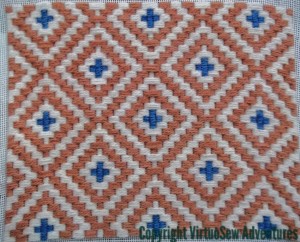
Stones Of Venice Panel
Oh dear, that didn’t take very long!
I’ve completed the top part of the footstool cushion using the Bargello pattern “Stones of Venice”. It grew very quickly, and although in the book it was described as an Advanced pattern, I found it fairly straightforward.
Each stitch goes across three, six, or nine threads, the stitches are grouped in threes, and the step between groups of three stitches is three threads. The most time consuming element, I think, was separating my wool and recombining one thread of each shade to create the heathered effect. Some of the other patterns mix up length of stitch, step between stitches, and groupings a great deal more, and must be much harder to keep track of!
However, now I need to stop and think. I need to stitch the vertical sides of the footstool cushion, and since I believe that wrapping the design around the sides will look awkward, I have decided to work each side panel separately. Now I just need a suitably Venetian border design that will work well with “Stones of Venice”.
It needs to be slightly smaller scale, I think, and I also need to allow for the fact that my stash of these colours is almost entirely depleted, and they may need to be supplemented, either by purchase or by using different shades in the borders.
Thoughts, anyone?
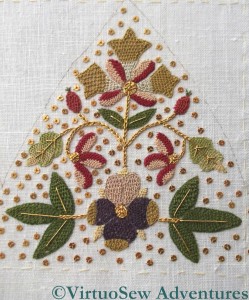
Pansy
Before I move on to work on the brim, here are close ups of two of the panels of the Nightcap. You will see, when you zoom in, the French Knots at the centre of the rose, contrasted with the Spiders Web stitch at the centre of the pansy.
You can also see that the spangles aren’t evenly spaced – there are some areas more densely spangled than others. I do think I have achieved a reasonably random placement, but humans are pattern-making animals, and it is really extraordinarily difficult to combine relatively even spacings with random placement! However, I am absolutely sure that attempting an even regular spacing would have had me stark mad if I had tried it!
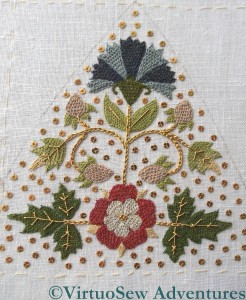
Rose
In ordinary light, the spangles don’t really shine as I am sure they would in the flickering light of a candle. When I have the piece finished and on display somewhere, I will probably have to spend a lot of time getting the lighting right – without using real candles…
Once I had taken the photographs, I tacked a calico cover over the completed crown of the nightcap, back and front, and turned the fabric over in the frame in order to start on the brim. Covering the finished work will stop me catching my threads on it, or knocking spangles off as I work.
I hope…

Moth Eaten Footstool
This rather sad specimen of a footstool – covered in now very moth-eaten Welsh tapestry fabric – was a constant part of my childhood. I can’t remember where it lived or what we used it for, but it’s always been somewhere around. When I realised that all my current stitching projects are very detailed and started casting around for something a bit chunkier, I thought that working a new cover for it would do nicely. Furthermore, if I chose threads I already had, it would make a good stash-buster.
Easier said than done. It took the combined efforts of my mother, my father, and myself to find a colour scheme. Even though I have a drawer full of wools, finding enough to meet the needs of the patterns we liked the look of required a great deal of swapping and changing. In the end, however, we picked a Bargello pattern shown in one of the craft books I inherited from my grandmother, “The Book of Creative Crafts”. The book was published in 1978, so the colour choices in the examples are sometimes a little unappealing to modern eyes, and there is also the fact that the top of the footstool is quite small – only 10 inches by 7.5. A couple of patterns that we liked, we felt were on rather too large a scale for the footstool.
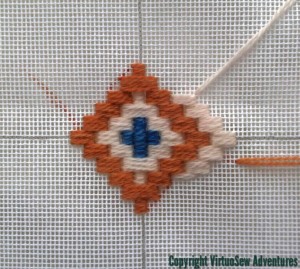
Starting Stones Of Venice
In the end, we chose a pattern called “Stones of Venice”, which is inspired by the brickwork of the Doge’s Palace. One of these days I must go to Venice, and see what I think of their version of it! Only three colours are involved, but as they are heathered, that allows me to extend my bundes of yarn, by using one strand each of two shades of each colour in my needle.
I’m using a roller frame with plastic extending sides which came to me in a bundle of stuff from a lady who was emptying her late mother’s house, and finding it a bit tricky to use. It seems to sag quite easily, and I’m unwilling to tighten the nuts any more in case they break the struts. It is the right size for the project, but other than that it is proving less than straightforward to use. Fortunately I suspect it won’t take long too work this piece!

Complete With Gold Thread
Gosh. Silkwork all done, and metal thread completed too. The experiments with the bordered detached buttonhole stitch with return must have got me a bit fired up, because as well as planning some variations on the brim, I incorporated some changes in the gold metal stitching on the crown. The two roses have a cluster of French Knots at their centres, instead of Eight-Spoked Spiders Web Stitches, and I quite deliberately have not used exactly the same run of lines for each variation.
I have to say that although I commented that my visit to “In Fine Style” showed me that I had not stitched my Detached Buttonhole Stitch with Return closely enough, I would hate to have to sink a metal thread through anything more closely stitched. I was on tenterhooks lest I damage the silk, or the metal thread, or create some sort of obvious flaw in the stitching.
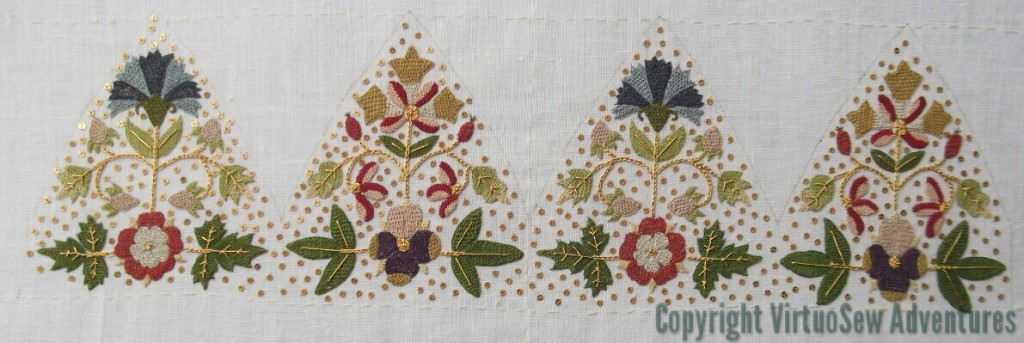
Spangled
The next stage was to add the spangles, since I want everything on this side finished before I turn the fabric over to start on the brim. Tricia says in the instructions that in the light of the experience they had with the Plimoth Jacket, she feels that they should have used more spangles, rather than fewer, and with that in mind she was much more generous with the provision of spangles than she would otherwise have been. I divided my packet of spangles roughly into six (one for each quadrant of the crown and two for the brim), and Spangled away enthusiastically.
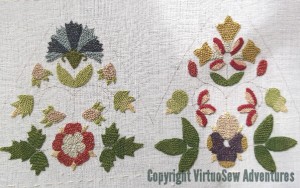
Silkwork On Cap Done
I’ve now finished the silk work on the main sections of the Glittering Gentleman’s Nightcap. The next stage is to work the metal thread embroidery, because I want everything on this side of the fabric done before I take it off the frame, turn it over and work on the brim. In the end, I found that the last few bits went quite quickly, perhaps because I had a whole day when I did nothing else and found the stitching speeding up. It’s taken me a while to realise it, but I now think that Detached Buttonhole Stitch With Return is one of those stitches which requires “flow”, which in turn doesn’t happen if you sit down with only time to do one leaf before doing something else!
Up until now, I have tended to regard the Online University projects I have done as a sort of salutary discipline, and worked them exactly according to the instructions (something I rarely do, even when I have instructions!), but during my last visit to a stitching show, I spent some time on Jacqui Carey‘s stand, talking to her, and acquiring her books about Elizabethan Stitches and Sweet Bags. One of the stitches she found, and “reverse-engineered” is effectively the “Detached Buttonhole stitch with Return” which forms so much of the stitchery on this piece, but it incorporates a border within the method of stitching. So I thought maybe on the brim I could used this bordered stitch instead of the standard stitch.
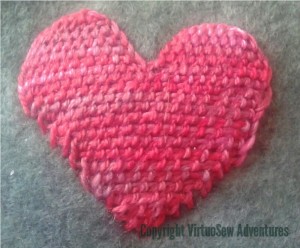
Unsuccessful Trial
In another departure from my usual procedure I decided to practise the stitch first, and it’s really just as well.
Perhaps because Jaqui is primarily a braid maker and not an embroiderer, it took me some time to adapt my way of thinking to make sense of her diagrams. She also shows the stitch as worked upwards, whereas I have worked downwards with this sort of stitch all my life – or at least ever since my first attempt, when I worked the Needlelace Embellished Blouse.
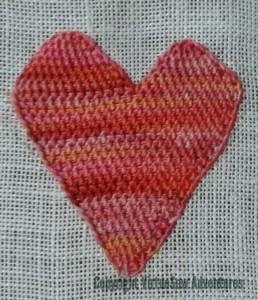
Second Trial Much Better
The fact that version one was worked on felt didn’t help, either, since the needle kept snagging it, and the felt sagged under the weight of the stitching.
So version two was worked on linen, using a mercerised cotton instead of pearl cotton. This time I think I have got to grips with the stitching and the way to create the border. The linen survived much better, but the mercerised thread kept trying to tie itself in knots!
Furthermore, try as I might to work the stitch as diagrammed – upwards and away from me – I kept turning the frame and working it sideways or downwards instead.
I probably will choose to use the stitch for at least some of the areas on the brim, but it will be interesting to see how I cope when I simply can’t turn the frame around!
Last week, not less than three of my assorted interests combined to give me a real treat.
The Queen’s Gallery in London is holding an exhibition called “In Fine Style“. The exhibition uses portraits of the Tudor and Stuart period to show the changes in fashion during the period, and there was a lot of embroidery and passementerie used, so the painters had a lot of scope. I’m interested in painting, too, so I’m always intrigued to see how a painter depicts texture, structure, and colour. Furthermore, major exhibitions these days often have additional events – not just a Private View on opening, but outreach events for schoolchildren, evening openings, tie-in events with other artists. An additional event caught my eye – an evening opening, followed by a recital of the music of John Dowland (contemporaneous with the paintings) given by the lutanist Jakob Lindberg.
Now, I’m an early music girl, so what with the chance to be nose-to-nose with some famous paintings and then to listen to music of the period surrounded by paintings of the composer’s assorted patrons…
I had a great time. There were some very familiar paintings – Elizabeth I as a princess, in a rose-red gown, with sleeves dripping gold embroidery, and a couple of pearl pendants you could swear you could pick off the canvas, van Dyck’s triple portrait of Charles I, Frances Stuart looking seductive in satin, with an entirely superfluous billow of fabric behind her. Familiar in reproduction, and fabulous. But, my goodness, the painting is even better when you can see it for real! Fur, gold thread, damask figured weaves, embroidery, gleaming pearls, glinting gems.
Then there were some unfamiliar ones. Edward IV, who I’ve read described as a blond beautiful giant, six foot tall, charismatic and something of a party animal. The portrait showed me a thin-faced, introspective man with dark red hair and a marked resemblance to the famous portrait of his brother Richard III – I suppose sitting for a portrait encourages introspection. Frances Stuart, in a buff coat like a man’s, her hair dressed to look like a man’s wig. Various unnamed men and women in the fashions of their time, in masque dress, fashionable clothes, clothes to make a statement. One lady wore a beautiful embroidered gown with a silvery gauze overdress set with crystals – imagine how many tiny brushstrokes you would need to bring a single crystal to life!
There were also some real examples – an embroidered jacket (not the Margaret Laton jacket, but very like it), a nightcap, and some gloves. And a Casket. And what a casket. It had a whole grove of needlelace-leaved trees planted on its’ lid, not to mention a horde of people frolicking around the side. And if I’ve learnt anything it’s that my detached buttonhole stitch is nothing like fine enough or tight enough. Sigh.
And the evening wasn’t over yet – after gloating over all that fabulous painted and embroidered finery, the recital! Jakob Lindberg is a great lutanist and a charming and knowledgeable man, so his introductions illuminated the music, and entertained the audience as much as his playing did. Though I did find myself wondering whether the composer had so attentive an audience when he played in the courts of England and Denmark!

Photo And Sketch
Since I finished the Lotus Flower Tile Fragment, I haven’t had a piece for the Dreams of Amarna to work on. I’ve been thinking about several, of course, but in combination with the Online University projects I’m working on and my sudden idea for the Vision Of Placidus, none of them really caught fire.
Then I filled very dull, dreary afternoon – pouring with rain, with no light to embroider by (remind me, it’s summer here in the northern hemisphere, right?) – with the preparations for working the solo version of the Hittite Amulet. He’s going to be worked in or nué – actually argent nué, since I’ll be using a silver thread! – so the first thing to do was prepare the base fabric.
There were two photos from the EES to choose from, one of them rather moody, with the amulet seeming to look out from the black background, and the other, arguably better lit, and full face rather than three-quarter. Guess which I chose?
Yes, of course, the moody, dramatic one!
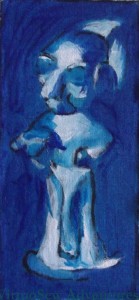
Ready To Stitch
It’s very hard to trace a picture that doesn’t show everything you know is there. You will see that the lines I’ve traced produce a sketchy effect, not complete detail. That’s because I decided to paint more of the details onto the background fabric to help guide my needle, and the lines were really only there to guide my brush!
It may seem that creating this painted panel is a lot of work that will be completely hidden, but while my other or nué panel, Christus Natus Est, had simple sweeping lines, and the coloured background was merely there to prevent cream calico from grinning through any gaps, the Hittite Amulet is a very much more intricate design. Creating my painted version putting darks and lights in the right places took immense concentration and I would hate to have to concentrate that hard on the design when the execution is going to be so challenging.
Wish me luck!
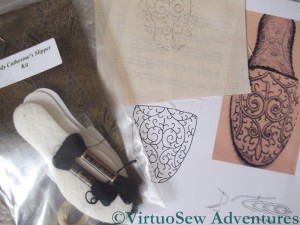
Lady Catherine’s Slipper
As though I haven’t enough to do, I have decided to do another of the Needlework Nibbles from Thistle Threads.
This one has gold curlicues edged in black and the background and lining are of black and gold silk brocade. I hesitated before deciding to take it on – black is a colour I’m not fond of – but since the gold was there to lift it, and since the various challenges of finishing the Nibbles are very good for me, I went ahead.

First Curlicue
In the instructions, Tricia suggests using brown Micron pen for the main curlicues and black for the ornamental curls. That’s a great idea, but as brown is all I have (from the Glittering Nightcap kit) and my local artists’ suppliers don’t know about Micron I shall simply have to stay alert, especially as the lines have turned out rather faint.
The embroidery in this case seems fairly simple – the golden curlicues are worked in Heavy Chain Stitch, one of my favourites, and the black silk will be worked in Stem Stitch and Split Stitch.
As usual, therefore, the challenge will be in the making up. It will probably take me a week or so, once I’ve finished the embroidery, to gather my courage to tackle the finishing!
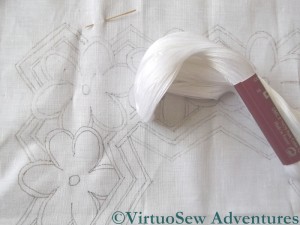
Finally Ready To Start
At long last, after much drafting, redrafting, pricking, pouncing, and outlining, the cutwork design I have planned to work using one of the patterns I found in the Azores is ready for me to start the embroidery.
After all this effort – the prick and pounce transfer method isn’t good for a healing tennis elbow! – I do hope I enjoy working it. It is only the second cutwork piece I’ve ever attempted – and the first came by accident in a bundle from eBay!
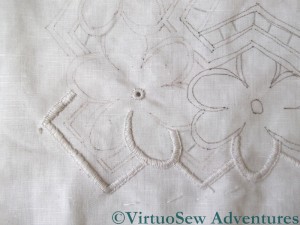
Making Progress
One of the things that attracted me to the design was the chance to get to grips with multi-ended buttonhole bars. I know that somewhere in my shelves of embroidery books, there is one detailing how these Y-shaped buttonhole bars should be worked, but in which?
I’m going to start by working the external edges, while I spend time rummaging among my references. This will ensure that it will not matter how long the rest of the piece takes, because the edges won’t be able to fray – although in fact I think there is little danger of that. It is a very good quality, firm fabric, and I’m rather enjoying myself.
I’ve even done my very first eyelet, using a bone stiletto from the set Elmsley Rose gave me for a birthday present a few years ago.
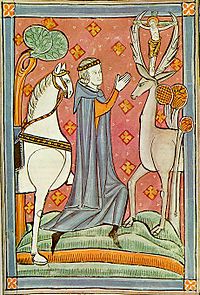
Conversion of St Hubert (Image from Wikipedia)
Shortly after I had my idea for a panel depicting the Vision of Placidus, I went to London for a lecture. The Pisanello is in The National Gallery, so after the lecture I took the opportunity, before catching the train home, to go to see the painting in real life. It turns out that St Hubert had a similar Conversion experience, so as well as the Pisanello “Vision of St Eustace” I found a fragment of an altarpiece entitled “The Conversion of St Hubert”…
I eventually tracked down the Pisanello, in the Sainsbury wing, and found it very much smaller than I expected – about A2 in size – which is much smaller than I am planning (about five foot by three foot). It was also just as dark as the reproduction I showed you in the first post about this idea. I sat down on a convenient window seat nearby, and started taking notes of the further research I need to do.
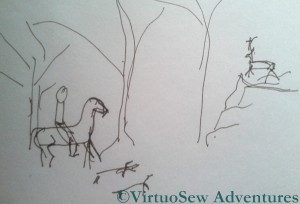
Sketch for the Vision Of Placidus
I will need picture references for
- a horse reined in from a gallop
- a stag with huge antlers
- hounds alert but not moving
- forest flora and fauna
- crucifix
- rocky outcrop
- suitably rich and exotic clothing for the huntsman
I also want to differentiate the vegetation from the background rather more, pull the rocky outcrop away from the background a bit more, and make the crucifix seem to grow out of the antlers rather more than it does in Pisanello’s painting.
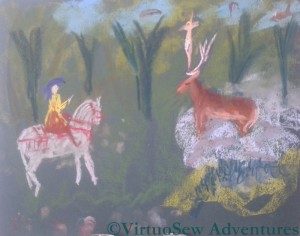
Placidus In Pastel
While I was there, I sketched a very approximate idea of the space I want in the picture – the Pisanallo and the altarpiece, and the picture above, are all quite compressed and condensed, and at the moment my idea is to have much more space and “air” in the design.
When I got home I had another go, this time in pastels. Some elements of the pastel work quite well – the horse and its harness, and the crucifix between the deer’s antlers. Others are not so good – the trees in the background are too regularly spaced and too similar in shape, and, like the Pisanello, there isn’t as much space between the stag and the horse as I would like.
I need to be careful, here. If I concentrate too much on creating painted sketches, I might drive out all the stitching ideas, but at the same time, the more I think about the design, the better the chance I have of producing a panel I am happy with!




















